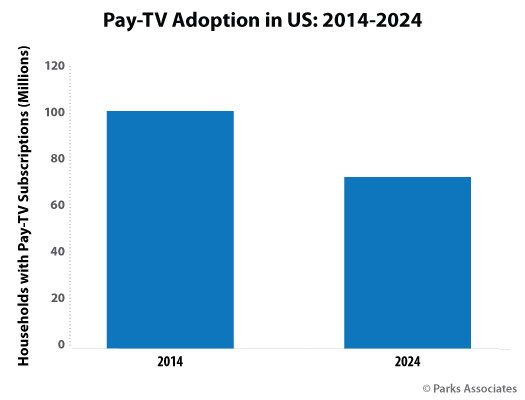
ADDISON, Texas—The number of U.S. households subscribing to traditional pay TV services will decline to 76.7 million by 2024, a drop of more than 25% from the high achieved in 2014, according to a new report for Parks Associates.
As expected, the report, “Video Services: State of the Market,” also reveals subscriptions and revenue have continued to decline as consumers increasingly embrace over-the-top (OTT) alternatives.
“There has been substantial innovation over the years, but streaming’s debut changed the trajectory of the modern video service industry,” said Paul Erickson, director of Research at Parks Associates. “The evolution of streaming video has given consumers immense choice in how, when and what they watch. The ease of trialing, subscribing and canceling services has created new dynamics and challenges for content companies and service providers.”
Traditional pay TV services are responding to the falloff in a number of ways, including offering their own streaming services, rebranding, making major acquisitions and building new partnerships. Those launching their own streaming services are entering a crowded field with more than 300 OTT services streaming directly to consumers in the U.S. alone, according to the researcher’s OTT video market monthly tracking service, called The OTT Video Market Tracker.
Parks Associates data also indicates nearly half of OTT service subscribers are jumping from service to service with OTT subscription data indicating a 48% average churn rate in the first quarter of 2022—up 10% from two years ago.
The research organization will examine these trends at its Future of Video: OTT, Pay TV and Digital Media conference, Dec. 12-14, at the Marina del Rey (Calif.) Marriott.
More information is available on the company’s website.
The professional video industry's #1 source for news, trends and product and tech information. Sign up below.
Phil Kurz is a contributing editor to TV Tech. He has written about TV and video technology for more than 30 years and served as editor of three leading industry magazines. He earned a Bachelor of Journalism and a Master’s Degree in Journalism from the University of Missouri-Columbia School of Journalism.


